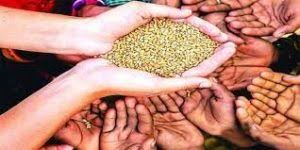National Food Security Act
National Food Security Act, 2013 |
தேசிய உணவு பாதுகாப்புச் சட்டம், 2013 |
| AIM | இலக்கு |
| To provides subsidized food grain to approximately 2/3rd of India’s population i.e. 75% in rural areas and 50% in urban areas. | இந்திய மக்கள் தொகையில் 3-ல் 2 பங்கு மக்களுக்கு உணவு மானியம் வழங்குதல். அதில் 75% ஊரக கிராமப்புற மக்களுக்கும், 50% நகர்புற மக்களுக்கும் வழங்குதல் |
| It converts the various existing food security schemes into legal entitlements (ie) from welfare based approach to right based approach. | முன்பு நடைமுறையில் இருந்த உணவு பாதுகாப்புத் திட்டங்களை சட்ட நடைமுறைக்கு கொண்டு வருதல். அதாவது நலத்திட்டங்களிலிருந்து உரிமை திட்டங்களாக மாற்றுதல். |
| It includes the Midday Meal Scheme, ICDS Scheme and the PDS. It also recognizes Maternity entitlements. | மதிய உணவு திட்டம், ஒருங்கிணைந்த குழந்தைகள் வளர்ச்சித் திட்டம் (ஐ.சி.டி.எஸ்.) மற்றும் பொது விநியோகத்திட்டம் ஆகியவற்றை உள்ளடக்கியது இச்சட்டம். மேலும் இச்சட்டம் பேறுகால உதவியை அங்கிகரிக்கின்றது. |
| Under NFSA, each beneficiary is entitled to 5 kg of food grains per month Rs.3, Rs.2, Rs.1 per kg for rice, wheat and coarse grains respectively. | இச்சட்டத்தின்படி, ஒவ்வொரு பயனீட்டாளர்களுக்கும் மாதத்திற்கு 5 கிலோ உணவு தானியம் முறையே ரூ.3, ரூ.2, ரூ.1 விலையில் அரிசி, கோதுமை மற்றும் தானியங்கள் வழங்கப்படும். |
| Every pregnant and lactating mother is entitled to a free meal at the local anganwadi as well as maternity benefits of Rs.6000, in installments. | இச்சட்டத்தின் கீழ் கருவுற்ற மற்றும் பாலூட்டும் தாய்மார்களுக்கு இலவச உணவு அங்கன்வாடியில் வழங்கப்படும். மேலும் பேறுகால உதவித் தொகையாக ரூ.6000 வழங்கப்படும். |
| The identification of eligible households is left to state Governments. | தகுதியான குடும்பங்களை அடையாளப்படுத்துல் மாநில அரசின் கடமையாகும். |
Current Affairs (Bilingual) – Click here
Download Mobile App – Click here
Other Notification – Click here


